Tuesdays with Tony
“No hoof, no horse”. Since you’re a horse person, you’ve probably heard this old saying, and it will always ring true. Let me purr-suade you to learn a little more about a common hoof problem – White Line Disease. You may have even seen it without realizing!
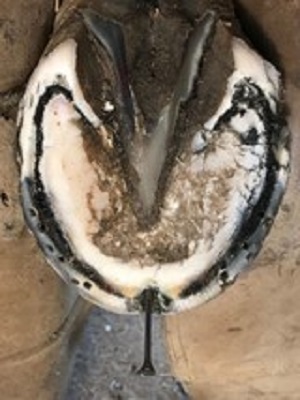
Mild white line at the toe
Also called seedy toe, white line disease can start with just a little separation at the hoof wall. Maybe you’ve gone a little too long between trims and your horse’s hooves have gotten a bit too long. You notice a small gap between the outer hoof wall and the sole, and some dirt is packed in there. That can be how WLD starts, and at this early stage it can be pretty manageable, but it can get out of control before you know it. Let’s go into what white line disease is, what causes it, and what you can do about it.
What is White Line Disease?
White line disease is basically an infection in your horse’s foot caused by bacteria and fungi getting into a gap in the hoof wall. The infection takes place in the tissue between the outer hoof wall and the sensitive inner tissues of the hoof. It doesn’t take any special evil organisms to cause this problem, it’s just the normal bacteria and fungi in your horse’s environment that are just waiting for the opportunity to find a nice place to set up shop. What they love is a dark, moist place, and a little space inside the hoof wall is their real estate dream. As the bacteria and fungi work their way into the hoof wall, they eat away at the tissue that should be keeping the hoof connected to the deeper structures. It’s a vicious cycle – once they access even further up inside the hoof and have a lovely dark, protected area, it gets much more difficult to clean them out. If you look at a foot with WLD, you’ll see a cavity between the outer hoof wall and the sole. You may be able to stick a hoof pick up in there and pick out some crumbly material that is the degraded hoof plus dirt, bacteria, and fungi.
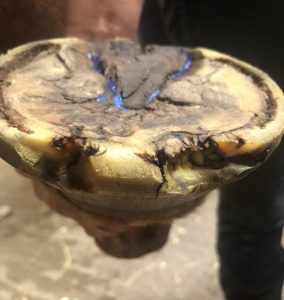
This foot has several spots where bacteria and fungi have invaded
You can find WLD on just one or two feet, or it can affect all four. In the early stages, your horse may not yet be sore, but as the tissue invasion becomes extensive, it can cause lameness. It can even progress to a very serious stage where the coffin bone loses connection to the hoof wall and begins to rotate (similar to, but different from, laminitis).
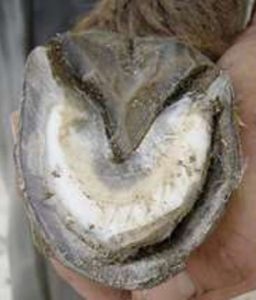
Half of this hoof wall is separated
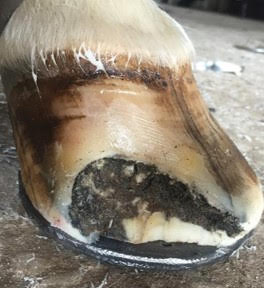
Look how far up inside this horse’s foot the dirt, bacteria, and fungi have travelled. The outer layer of the hoof wall has been cut away to treat the infection.
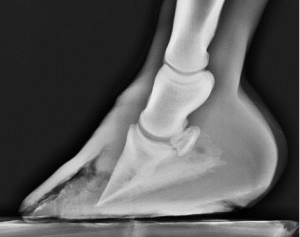
Severe WLD has caused this coffin bone to rotate
What causes it?
Like I said, bacteria and fungi are involved in WLD, but it’s not so simple as that, because the bacteria and fungi are always there in the environment, and not every hoof gets WLD. So how do they get into a foot?
It comes down to a separation that occurs in the hoof that gives the organisms a chance to invade – the bacteria and fungi are just there to take advantage of it. Why does that separation occur in the first place? Poor trimming or sometimes a conformational issue such as club foot can be the cause. A horse with chronic laminitis can also be at greater risk due to the loss of integrity of the hoof. Most commonly, a long toe or overgrown foot can distort the hoof and cause mechanical stress that leads to the hoof wall separating near the white line. Just another of the 10,000 reasons it’s important to stay on top of your horse’s hoof care and get him a quality trim at a regular interval.
Any age, sex, or breed of horse can be affected. While it can occur in any climate, it’s more common in humid conditions (ahem, Florida anyone?) since wet footing can soften the hoof and allow the organisms easier entry into the tissues.
How do we treat and prevent White Line Disease?
First, we have to recognize the WLD. You’ll want to pay close attention to your horse’s feet when you’re picking them out. If you think there are any areas of separation, pockets of dirt, and crumbly hoof near the white line, talk to my doc and your farrier. If your horse wears shoes, it’s a little trickier to observe this area, so your farrier should take a good look when she removes the shoe to trim the foot. One of the best things you can do to prevent WLD is just to have your horse trimmed frequently (about every 5 weeks, depending on the horse) and to make sure the toes don’t become too long. A well-trimmed foot is much less likely to develop this problem. On top of that, pick your horse’s feet regularly and give them a chance to dry out. Admittedly, the drying part can be tricky during some times of the year.
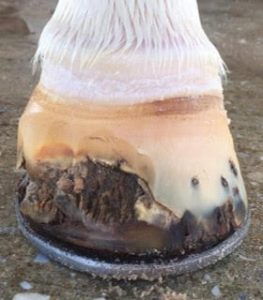
A hoof wall resection. You can see the new healthy hoof growing down from the coronary band.
If your horse does develop white line disease, my doc and your farrier should work together to develop a treatment plan. Unfortunately, just picking the cavity out and applying medications is unlikely to stop the progression. A very minor WLD may be able to be trimmed out by your farrier during a routine visit. Larger areas of separation will require additional treatment. My doc may need to take a radiograph to see how extensive the damage is within the foot. She’ll need to correct any abnormal forces on the foot (such as an overgrown toe) that are causing the separation. All the other treatment will not really be effective if the primary cause isn’t fixed.
Next, my doc has to stop that bacteria and fungus in their tracks. The most important part is to remember what those organisms love – a nice dark, moist space that can’t easily be cleaned out. So my doc takes the roof from over their head by performing a hoof wall resection! Those critters don’t stand a chance once their hiding place is exposed to light and air. My doc uses a hoof nipper or Dremel to remove the outer layer of hoof wall from over the cavity. The organisms are prevented from hiding up there, and the infected area is exposed for medications to be applied. Medical treatment is almost never useful unless the hoof wall over the infection is removed, so don’t waste your money on the various lotions and potions that make lofty claims.
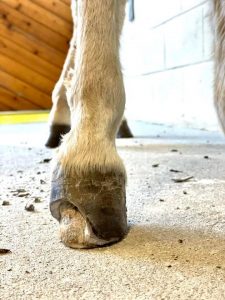
This hoof required an extensive resection to remove the diseased tissue. Normal hoof will grow downwards from the coronary band over the next few months. This horse was walking sound right after the resection.
I’ve been watching my docs do a bunch of hoof wall resections lately from my spot in the middle of the barn aisle. It can look a bit dramatic to see a bunch of hoof wall removed, but don’t worry, it’s actually only the outer part of the hoof that is already disconnected. So there’s no bleeding, and it’s not painful to the horse. It’s much better than leaving the bacteria and fungus to eat away at the hoof. If a lot of hoof wall must be removed, a shoe can be helpful to stabilize the foot until new hoof grows down.
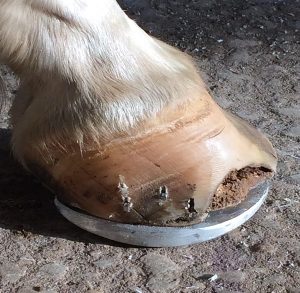
A rocker shoe is being used in this case to support the hoof and to improve the horse’s breakover. This is the same horse as in the x-ray above.
Once the outer hoof wall is removed, you’ll need to keep the hoof clean. My doc likes to soak the hoof in CleanTrax once a week to disinfect the hoof. The new, healthy hoof wall will grow downwards from the coronary band and as long as you have corrected the primary problems, your horse should grow in a normal hoof!
Until next week,
Tony
P.S. If this wasn’t enough info to make you purr, you should check out the podcast my humans recently did on White Line Disease. It’s loaded with interesting discussion, and you can listen free right from your phone or computer. Check it out over on the Podcast Page of my website.
Tuesdays with Tony is the official blog of Tony the Clinic Cat at Springhill Equine Veterinary Clinic in Newberry, Florida. If you liked this blog, please subscribe below, and share it with your friends on social media! For more information, please call us at (352) 472-1620, visit our website at SpringhillEquine.com, or follow us on Facebook!
[jetpack_subscription_form title="Subscribe to Whinny's Wisdoms"]

